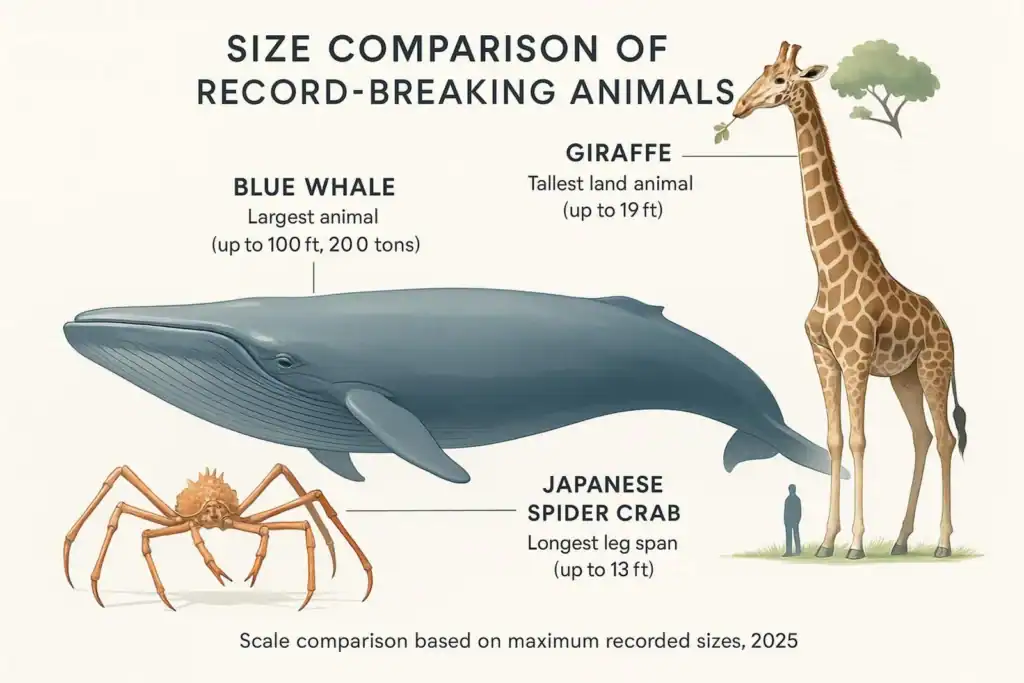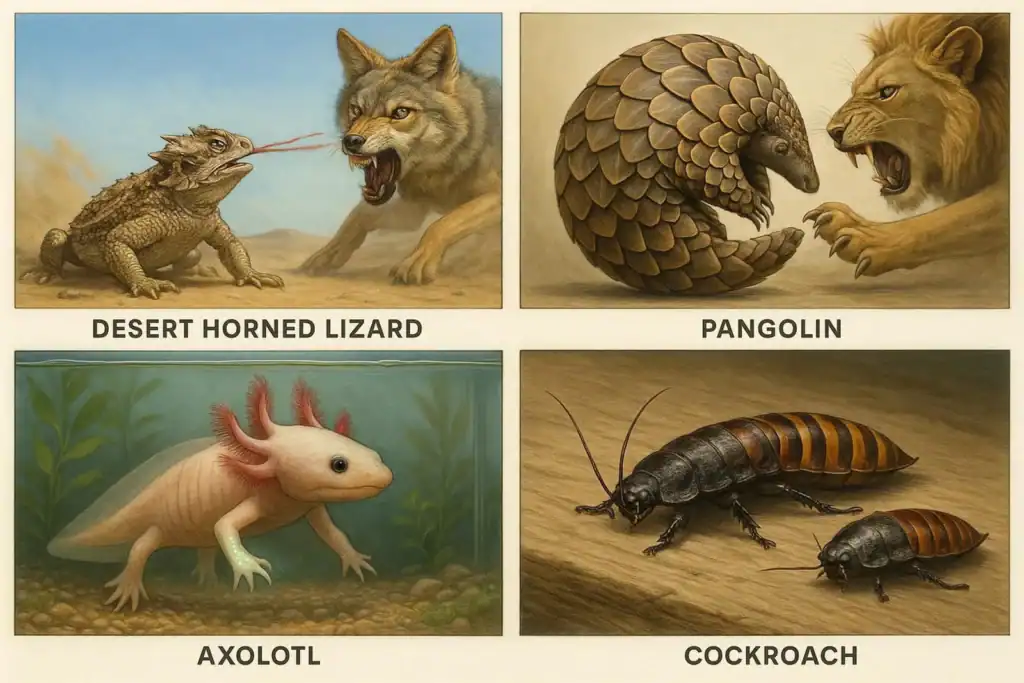Animals never stop surprising us. From tiny insects to huge mammals, every species has traits that set it apart. Facts about animals break our old ideas and show a world that is far more creative and varied than we expect. These short nuggets of info often point to the strange, the rare, and the hard to believe, which sparks curiosity and a stronger respect for nature.
Whether it’s a creature with a strange defense, a quirky diet, or clever thinking, animal facts open a window into life on Earth. They push us to look past what we know and to notice how evolution finds smart ways to fill every niche. Learning that a small shrimp can snap hard enough to make a flash of heat almost as hot as the sun, or that dolphins seem to play with pufferfish toxins, shows how many surprises nature still holds.
Why Are We Drawn to Unusual Animal Behaviors?
We are pulled in by odd animal behavior because we want to make sense of the world. These actions often echo parts of our lives, like family bonds, teamwork, and survival. Otters holding hands while sleeping so they don’t drift apart feels familiar and tender. Wolves hunting together or whales sharing complex calls highlight the strength of working as a group.
These unusual habits also teach lessons about how species adapt and keep going. A wood frog can freeze solid and thaw back to life, and a tardigrade can tolerate extreme conditions. Stories like these remind us how life can solve tough problems in surprising ways.
How Do Animal Adaptations Surprise Us?
Adaptations often feel like they bend the rules of what’s possible. Evolution shapes bodies and behaviors that fit a habitat so well they can seem unreal. The duck-billed platypus is a mammal that lays eggs and “sweats” milk for its young. The horned lizard can squirt blood from its eyes to scare off attackers.
Adaptations include more than body shape. They also cover internal systems and behavior. A polar bear’s black skin under white fur helps it soak up heat. Male seahorses carry and give birth to babies, flipping the usual script on parenting. Each example tells a long story of change over time, showing how life finds many ways to succeed.
Record-Breaking Animals: Size, Speed, and Lifespan
Nature is full of record-setters, from giants to tiny powerhouses, sprinters to slow-and-steady elders. These animals stretch our sense of what is possible and show many paths to survival.
Looking at these champions gives a quick look at how varied ecosystems are. Even today, there is still so much to find, often in places we don’t expect. These record holders keep us amazed with their unusual skills.
Which Animals Hold World Records for Size?
The blue whale is the biggest animal alive. Its tongue can weigh 2.7 tonnes (6,000-8,000 pounds), as much as a car or small elephant. On land, the giraffe is the tallest, reaching 19 feet (5.8 meters), with over 7 feet of neck built for browsing high leaves.

| Animal | Record | Measurement |
|---|---|---|
| Blue whale | Largest animal | Tongue ~2.7 tonnes |
| Giraffe | Tallest land animal | Up to 19 ft (5.8 m) |
| Japanese spider crab | Longest arthropod leg span | Up to ~13 ft (4 m) |
| Meganeuropsis (“giant dragonfly”) | Largest ancient insect | Wingspan 2.5 ft (75 cm) |
Among invertebrates, the Japanese spider crab has the longest leg span of any arthropod. And long ago, the huge “dragonfly” Meganeuropsis spread wings more than 75 cm (2.5 feet) wide and hunted with ease.
What Are the Fastest Animals on Land, Sea, and Air?
Speed helps hunters catch food and prey escape danger. The cheetah is the fastest land animal, hitting 75 mph (120 kph) in short bursts with sharp turns and quick starts.
| Habitat | Animal | Top Speed |
|---|---|---|
| Land | Cheetah | 75 mph (120 kph) |
| Air (dive) | Peregrine falcon | 242 mph (389 kph) |
| Air (level flight) | Brazilian free-tailed bat | ~100 mph |
| Sea | Sailfish / Black marlin | ~22 mph (36 kph) |
In the air, the peregrine falcon is fastest in a dive. For flat flight, the Brazilian free-tailed bat reaches about 100 mph. In water, sailfish and black marlin swim up to 22 mph (36 kph).
Which Animals Live the Longest?
The Greenland shark is the longest-lived vertebrate known, with estimates over 400 years. These slow-growing sharks, up to 5 meters long, live in cold deep waters of the North Atlantic.
Adwaita, an Aldabra giant tortoise, was said to be about 255 years old when he died in 2006, though that age has not been fully confirmed. A radiated tortoise from Madagascar lived 188 years, the longest confirmed for a land animal. These ancient reptiles show how slow life histories can stretch time.
What Are Some of the Shortest-Lived Creatures?
Some species live fast and focus their adult stage on breeding. Mayflies hold the record for the shortest adult life. Some live only 24 hours, and some just 8-10 hours. During that time, they mate and lay eggs. They spend far longer-often 3-7 years-as nymphs in water before their short adult stage.
These brief lives show another way to survive: reproduce quickly and pass the torch to the next generation. It’s a sharp contrast to animals that can live for centuries.
Strange and Surprising Animal Abilities
Animals have many odd and impressive skills, shaped by natural selection. These tricks help them defend themselves, talk to each other, and eat in unusual ways. From heat bursts to clever tool use, nature keeps delivering shocks and delights.
These abilities are tools for survival that help species cope with hard places and outsmart rivals. They remind us that biology has wide boundaries and that evolution keeps finding clever fixes.
Which Animals Have Unique Defenses or Superpowers?
- Horned lizard: Can shoot blood from its eyes up to 3 feet. The blood tastes bad to predators. Some can also puff up to look much larger.
- Pangolin: Rolls into a tight, scaly ball that even lions struggle to open. Sadly, this makes it easy for poachers to pick up.
- Cockroach: Can live for weeks without a head; the head can survive for hours on its own because of its simple nervous system.
- Axolotl: Can regrow limbs and organs, even parts of the brain, several times.

Animals with Extraordinary Senses and Communication
- Great white shark: Can smell a single drop of blood in 25 gallons (100 liters) of water and pick up faint traces from miles away using its olfactory system.
- Colossal squid: Has eyes the size of basketballs to spot faint light from 400 feet (120 meters) away in deep water.
- Dolphins: Use signature whistles that act like names for one another.
- Howler monkey: Loudest land animal; calls carry for 3 miles (5 km) and can hit about 140 decibels.
- Roosters: Tilt their heads to cover their ear canals when crowing, helping protect their hearing.
Unusual Feeding Habits and Diets
- Flamingos: Are born gray; they turn pink from canthaxanthin in brine shrimp and algae. Zoos add this pigment to their diet.
- Giant anteater: Eats up to 35,000 ants and termites a day with a long sticky tongue. It often leaves part of a nest so it can return later.
- Dementor wasp: Stings a cockroach in the head to stop fear signals, then leads it to a nest to lay eggs on it.
Animal Intelligence and Social Behaviors
People aren’t the only thinkers. Many animals solve problems, use tools, and form layered social groups. These findings show rich inner lives and flexible minds across many species.
Learning how animals think and live together builds respect for other species and offers clues about how minds and communities work. It also asks us to rethink our role on this planet.
Which Animals Use Tools or Show Problem-Solving?
- Chimpanzees: Use sticks to fish for termites and have even made simple “spears” to hunt bushbabies.
- Corvids (crows, rooks, ravens): Solve puzzles, use tools, and recognize people. Rooks show physical understanding on par with a 6-month-old human in tests, and in some tasks they beat apes.
Unexpected Friendships and Communication
- Otters: Hold hands while sleeping so currents don’t separate them.
- Dolphins: Use name-like whistles to identify each other in complex social groups.
- Vampire bats: Share blood meals with friends that shared with them before, which helps the group survive.
Weird and Wonderful Reproduction in the Animal Kingdom
Life continues in many unusual ways. Animals mate, carry young, and raise offspring with a huge range of methods. Some bend the usual rules for who carries babies and how new life begins.
These odd strategies add to our view of biology and show how life cycles balance survival with breeding. Surprises are common, and limits keep getting pushed.
What Are the Most Unusual Ways Animals Reproduce?
- Male seahorse: The male carries up to 2,000 babies in a pouch and gives birth, a rare case where the father handles the pregnancy.
- Mourning gecko: All-female species that reproduces by parthenogenesis (cloning). Around 70 species worldwide-from some snails to Komodo dragons-can do this in certain cases.
Which Parenting Behaviors Are Most Surprising?
- Cuckoo bird: Lays eggs in other birds’ nests; host parents raise the chick.
- Meerkats: Bring dead or disabled scorpions to teach pups hunting skills safely.
- Elephants: Show strong grief; they return to places where family members died and stand quietly over bones with lowered heads.
Mammal Facts That Will Blow Your Mind
Mammals may feel familiar, but many facts still shock us. Hidden skin colors, sleep habits, and odd similarities with humans all point to wide variety within this group.
These findings keep science lively and remind us that we still have a lot to learn about animals we see every day.
Rare and Little-Known Mammal Behaviors
- Polar bears: White fur covers black skin that helps absorb sunlight for warmth, while the fur hides them on the ice.
- Koalas: Sleep 18-22 hours a day because eucalyptus leaves are low in energy, fibrous, and toxic, so digestion uses a lot of energy. Their fingerprints are so close to human prints that they have confused crime scene work.
Bird Brilliance: Surprising Avian Insights
Birds show off with color, flight, and long trips across the globe. Many carry out hard tasks, produce wild sounds, and follow social rules that are complex and varied.
These facts reveal how flight, habitat choice, and life cycles work together in clever ways. Even common birds can hide special skills.
Incredible Bird Migrations and Feats
The grey-headed albatross can circle the planet in about 46 days, covering roughly 14,000 miles at around 13 mph with stops along the way. The alpine swift holds the record for the longest uninterrupted flight, staying in the air for more than 200 days while hunting insects. One swift was recorded resting only two hours over ten months.
Emperor penguins march 50-120 km (31-75 miles) across Antarctic ice to breed in winter. They face brutal cold to raise chicks and can stay underwater for up to 27 minutes, a sign of their strong marine skills.
Birds with Bizarre Calls and Displays
The shoebill stork has a massive, shoe-shaped bill over 20 cm long and nearly as wide, perfect for swallowing baby crocodiles and lungfish whole. It is a powerful hunter in wetlands.
Some corvids like crows and ravens pull pranks on each other, pointing to sharp minds and playful social lives. Gentoo penguins offer pebbles in courtship as a “proposal” gift to a mate, marking a pair bond in a sweet and simple way.
Reptile and Amphibian Oddities
Reptiles and amphibians come from ancient lines and show many strange tricks. Many live between land and water and have bodies built for both. Their defenses, feeding styles, and survival skills are full of surprises.
These animals push our picture of what an animal can be and show how many forms life can take.
What Are the Most Fascinating Reptile Facts?
- Nile crocodile: Bite force near 5,000 psi-the strongest recorded-about 10 times that of a great white shark. Yet a croc cannot stick out its tongue.
- Inland taipan: Most venomous snake; one bite could kill at least 100 adults without treatment. Few human bites occur, and fast antivenom saves lives.
- Chameleon: Tongue is as long as its body and shoots out fast to grab prey.
- Painted turtle: Can absorb oxygen through membranes in the cloaca while underwater during winter, which works like “butt breathing.”
How Do Amphibians Defy Expectations?
- Wood frog: In Alaska, spends about seven months frozen. Two-thirds of its body water turns to ice; heart and blood flow stop, yet it thaws in spring and hops away thanks to special antifreeze compounds.
- Lungfish: Has both lungs and gills. When water dries up, it burrows into mud and breathes air, waiting for rains to return.
These feats show how animals cope with harsh seasons and changing conditions.
Jaw-Dropping Facts About Insects and Invertebrates
Insects and other invertebrates are small but full of power, complex societies, and tough survival skills. They shape many ecosystems and bring wild records in speed, strength, and endurance.
From tiny rockets to near-indestructible survivors, these creatures prove that size does not limit what life can do. Many wonders hide right under our feet.
Which Insects Are Record-Breakers?
- Flea: Jumps up to 200 times its body length-about 10 inches (25 cm) up and 18 inches (45 cm) across.
- “Dracula ant”: Snaps its jaws from 0 to 200 mph in 0.000015 seconds, about 5,000 times faster than a human blink.
- Ants: Estimated at 107-108 billion individuals, far outnumbering humans, and present on nearly all land masses.
- Garden snail: Uses a radula with up to 14,000 tiny teeth (some species over 20,000) to scrape food.
Spectacular Behaviors and Survival Skills
- Honeypot ants: Some workers gorge on nectar until their bellies swell like grapes; they act as living food stores and feed the colony later.
- Tardigrades (water bears): Survive in space, go more than 10 years without food, endure 149°C heat or -272°C cold, and handle crushing pressure far beyond ocean trenches.
- Bees: Have five eyes-two large compound eyes and three small ocelli on top that sense light and help spot threats.
Marine Marvels: Ocean Animals and Their Hidden Talents
The ocean covers most of Earth and holds animals with striking skills. From sunlit shallows to deep trenches, marine life shows many ways to hunt, hide, and talk in water.
Studying these creatures builds our respect for sea life and shows how sea systems depend on many parts working together.
What Are the Most Impressive Marine Adaptations?
- Pistol shrimp: Only about 2 cm long, yet the loudest animal on record. A claw snap makes a bubble that collapses with a 230-decibel pop and a quick flash of heat near 4,400°C, stunning prey.
- Giant Pacific octopus: Has three hearts, nine brains, and blue blood. Changes color and texture instantly to hide or hunt.
- Pufferfish: Holds tetrodotoxin, up to 1,200 times more deadly than cyanide. One fish can hold enough toxin to kill 30 adults. In Japan, licensed chefs carefully remove toxic parts to prepare fugu.
Interesting Facts About Ocean Giants and Tiny Wonders
- Sperm whale: The largest predator, up to 20 meters and 80 tonnes, dives near 3,000 meters to hunt giant squid. Scars from squid beaks mark many adults.
- Pea crab: A tiny crab that lives inside oysters, clams, and mussels and feeds from the host.
- Mariana snailfish: Lives around 8,000 meters deep in ocean trenches and eats small invertebrates.
- Dolphins: Have been filmed passing a pufferfish around, likely getting a mild dose of toxin with a trance-like effect.
Frequently Asked Questions About Fun Animal Facts
People have lots of questions about animals, and many answers keep changing as new findings appear. We ask how many species exist, sort out myths, and wonder about things science has not solved yet. These questions show our curiosity and keep the search for knowledge moving forward.
Answering common questions clears up confusion and also shows how deep and complex life can be. The more we learn, the more new puzzles appear.
How Many Animal Species Are There on Earth?
Current estimates suggest about 8.7 million species live on Earth. More than 80% may still be unknown. That means for every species we have named, several more are still waiting for discovery and study.
Based on today’s data and models, it could take around 500 years to find and catalog them all. Each new species we find adds another piece to the big picture of life.
What Are the Most Commonly Misunderstood Animal Facts?
Some popular facts get mixed up. For example, polar bears look white, but their fur is clear and hollow, reflecting light to appear white. Their skin underneath is black, which helps absorb heat.
Group names can be quirky. A group of parrots is a “pandemonium,” and a group of porcupines is a “prickle.” These specific terms add color and accuracy to how we talk about animals.
Why Are Some Animal Facts Still Unknown to Science?
Many habitats are hard to reach. Deep seas, thick rainforests, and remote polar areas hold species we rarely see. The Greenland shark, for example, lives far below the surface in cold waters, so we still know little about its life.
Some species are tiny, active at night, or very shy, which makes study hard. Many species also remain undiscovered. Animal talk, social life, and internal biology can be very complex, too. Dolphins appear to use names, but we are still working out what that means in full. With new species and behaviors turning up all the time, the search to understand animals keeps going-and keeps surprising us.








































